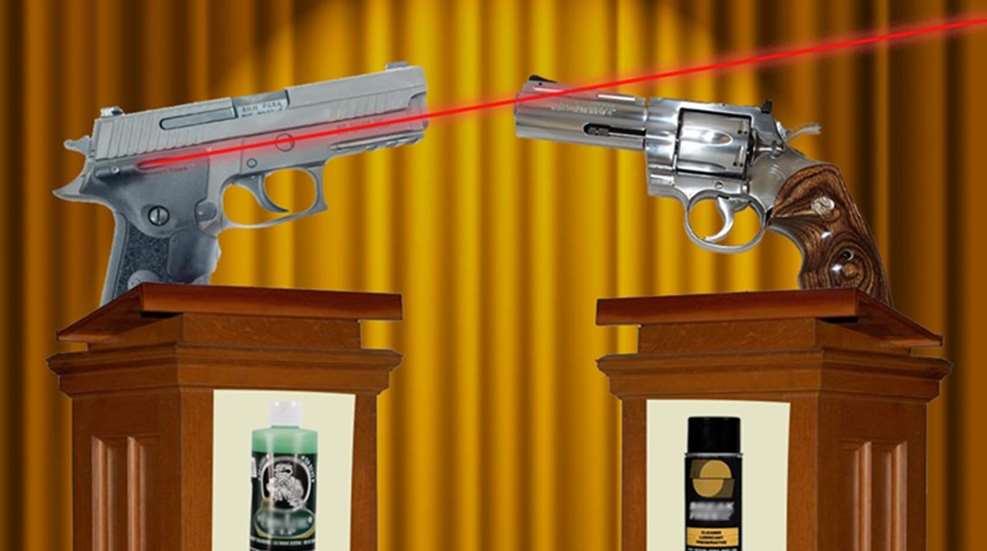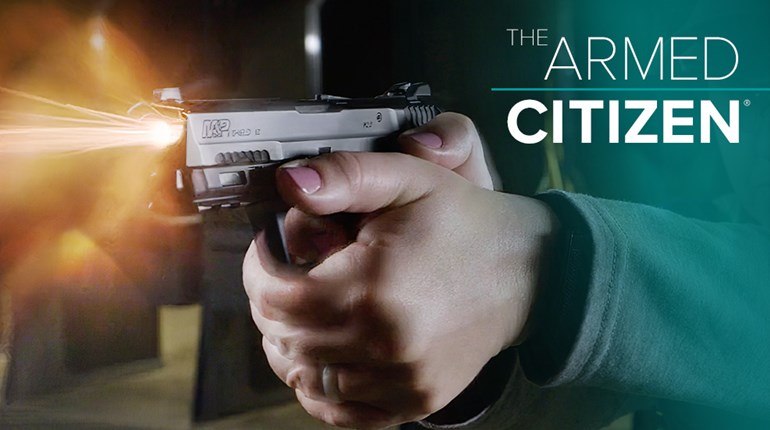
So, you want a gun for concealed carry, but you can’t decide between the venerable 9mm and the handy .380 Auto. While I’m not going to solve the debate for everyone, I will provide you with some facts and insights to make your choice easier. Before we get started, however, there are some points you should know:
- Water capacity is the standard measurement for case capacity comparison, because powder volumes vary.
- Due to the laws of physics, any given cartridge will produce less perceived recoil if fired from a heavier gun, while a lighter gun will result in more.
- Less recoil, in general, means more accurate shooting and faster followup shots. Gun writers call this “shootability,” although it’s definitely a very subjective term.
9mm Luger
The 9mm Luger (aka 9mmX19, 9mm Parabellum) is likely America’s most popular handgun cartridge because it offers a balance of power, shootability, reliability and concealability. Because of these traits, the cartridge has become so popular that it has gained another advantage: options. If you choose 9mm, you are immediately granted myriad options in loads, handgun models and accessories for your new gun.
A 9mmx19 cartridge features a bullet that is 9mm, or .355 inches in diameter. Bullet weights range from 80 to 147 grains with 115- and 124-grain bullets being the most popular. Its case is .380 inches in diameter, 19mm long and can hold a maximum of 10 grains of water. A typical 9mm Luger load contains about 6 grains of powder used to propel a 115-grain bullet to 1,000 feet per second (fps) out of a 2.75-inch barrel. (Velocities increase along with barrel length.) This produces approximately 255 ft.-lbs. energy while generating 5.36 ft.-lbs. of recoil energy from a pistol weighing 1 pound.
.380 ACP
Firearms chambered in .380 Automatic Colt Pistol (aka, .380 Auto, 9mmx17, .380 Browning Court, 9mm Short, .380 Corto) are continuing to grow in popularity. That’s because the cartridge, with its very short case, can be made to function safely and efficiently in extremely small-framed guns. Because the pressures produced by the little cartridge aren’t excessive, the guns don’t require pounds of steel reinforcement, like, for instance a .44 Magnum. Yet the cartridge is more powerful than other small-framed guns such as .22 LR, .25 ACP and .32 S&W. Yet even in a lightweight gun such as the 10-ounce Ruger LCP, recoil is mild thanks to the .380’s modest ballistic data. Consider the following specifications:
The .380 Auto features the same diameter bullet as the 9mm and the same diameter case, yet it is shorter at 17mm in case length. It can hold a maximum of 5.3 grains of water. A typical load carries roughly 3 grains of powder that propels a 95-grain bullet at 845 fps to produce 151 ft.-lbs. of energy from a 2.75-inch barrel. It produces about 2.76 ft.-lbs. recoil energy from a 1-pound firearm.
So, when compared to the 9mm Luger, the .380 is smaller, lighter in recoil but not as powerful when it strikes a target. Now let’s take a look at the numbers in more detail.
Head to Head
While 255 ft.-lbs. of bullet energy from the muzzle of a 9mm Luger is not a lot in the firearm world—consider that an average .30-06 deer rifle produces around 2,500 ft.-lbs. energy—a 9mm’s energy is far greater than a .22 LR’s piddly 105 ft.-lbs. and many other smaller calibers. It has about 68 percent more energy than the .380 Auto. The question then: Is this extra power worth the 9mm’s extra weight?
If all things are equal, more velocity means greater penetration. A 9mm Luger typically out-penetrates .380 Auto bullets, but not as much as you might think. That may be due to the fact that the 9mm’s extra energy causes its bullets to expand to a slightly greater diameter, and expansion retards penetration due to greater surface area. But if two bullets penetrate the same distance, the one that has greatest surface area is best because it produces more tissue damage. No doubt, due to its advantage in velocity and energy, the 9mm Luger is the clear winner in terminal performance.
But for the same reasons, the .380 wins in shootability, with one caveat. Because the 380 has 94 percent less recoil (if fired from an equal-weight gun), it’s easier to shoot. But, you must consider that 9mms are typically a few ounces heavier than guns chambered in .380, and so the extra weight reduces that 94 percent figure considerably. Also, the smaller the gun, the smaller its grip and the more recoil it has. So a .380’s advantage in shootability is somewhat negated when fired from the smallest guns available. You should also remember that “shootability” isn’t everything, or we’d all carry peashooters. Carry caliber choice, until the laws of physics are altered, boils down to finding a tradeoff between shootability, gun size and power that works for you. It’s important to remember that the bigger gun you get, the tougher it is to conceal, but the easier it is to shoot.
Some of the smallest and most concealable guns made—which still maintain the prerequisite features for serious carry consideration—are chambered in .380 Auto due to the cartridge’s diminutive size. Examples are the 8.3-ounce Kel-Tec P3AT, the 9.97-ounce Kahr P380, and the 8.8-ounce Diamondback DB380. (All these guns weigh just under a pound when fully loaded.) On average, 9mm versions of these guns weigh 4 to 5 ounces more. Five ounces doesn’t seem like much, but for most people it’s the difference between a true pocket gun that you can wear in your front jeans or shorts pocket without it pulling down your pants, and a 20-ounce (fully loaded) gun for which you probably need a belt and a holster. In terms of pure concealability, the .380 is the clear winner.
For options and choices, the 9mm wins again. More gun models at all price ranges, holsters, ammo and accessories can be found for it than perhaps any handgun (with the possible exception of the 1911). One notable option here is ammunition. The 9mm, because of its larger case capacity, can be downloaded to a .380’s velocity if needed, or uploaded to +P status where it can produce velocities of 1,200 fps and energies nearing 400 ft.-lbs. if called for.
Lastly, while there is no discernible difference in reliability between the cartridges themselves, bear in mind that in general, lighter-weight guns are less reliable than heavier guns of equal quality. So, if you choose a .380 in a 10-ounce gun, while it shouldn’t jam often, it will likely experience more malfunctions over time than a full-sized handgun would. That’s just how it is.






































